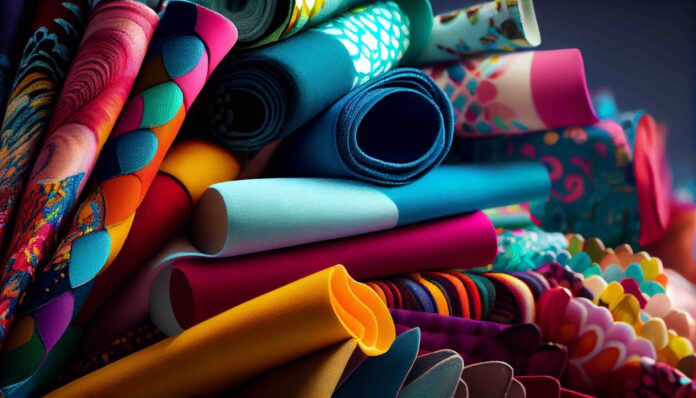Understanding Different Types of Fabric and Their Uses
The Role of Fabric in Decorating: An Introduction
When it comes to decorating our homes, fabric plays a crucial role. Whether it’s an upholstered sofa in the living room, drapery panels in the bedroom, or throw pillows on the couch, fabric is everywhere.
In fact, it’s one of the most important elements that can make or break a room’s design. Not only does it add color and texture to a space, but it also helps create a sense of warmth and coziness.
The right fabric choice can elevate a room from ordinary to extraordinary. It has the power to transform any space into a cozy haven or elegant oasis.
Fabric’s versatility and range of styles and colors allow decorators and homeowners alike to express their creativity while also providing practical solutions for different applications. The purpose of this article is to help you understand different types of fabrics used for decorating so you can choose the best ones for your projects.
We will cover everything from basic cotton weaves to luxury velvets so you can make informed decisions when selecting fabrics for your home décor projects. So let’s dive in!
Understanding Fabric Basics
Natural Fibers
When it comes to fabric, you’ll generally come across three main types of fibers: natural, synthetic, and blends. Natural fibers come from natural sources like plants and animals.
Some common examples include cotton, wool, linen, silk, bamboo, and hemp. Natural fibers are typically more breathable than synthetic ones and can be more comfortable to wear.
Synthetic Fibers
Synthetic fibers are man-made and created through a chemical process. They’re often cheaper than natural fibers and can be easier to care for because they’re less prone to wrinkling or shrinking. Some common examples include polyester, nylon, rayon, and spandex.
Blends
Blended fabrics combine natural and synthetic fibers. This can give you the best of both worlds – the breathability of a natural fiber with the durability of a synthetic one. For example, cotton-polyester blends are often used in clothing because they’re comfortable while also being easy to care for.
Fabric Weaves
The type of weave used in a fabric affects its strength and appearance. Weaves can be classified as either plain weaves or complex weaves.
Plain weaves consist of yarns that cross over each other at right angles (think about a checkerboard pattern). Complex weaves include satin weaves (where the yarn is woven over multiple threads) or twill weaves (where diagonal lines appear on the face of the fabric).
Fabric Finishes
Fabric finishes refer to treatments applied after weaving or knitting that change how the fabric looks or feels. For example, some fabrics might be brushed for extra softness while others might have chemicals added to improve their moisture-wicking properties.
Different finishes can also impact things like how easily a fabric wrinkles, how well it holds color, and how easily it can be cleaned. Understanding the different types of fabric finishes can help you choose the right fabric for your project.
Common Types of Fabric for Decorating
Cotton: The Versatile and Easy-to-Care-for Fabric
Cotton is a natural fiber that is widely used in decorating because of its versatility. It can be used for drapes, upholstery, bedding, and even clothing. Cotton is easy to care for since it can be machine washed and dried, making it perfect for busy households.
It’s also affordable and comes in a wide range of patterns and colors. When choosing cotton fabric for decorating purposes, you’ll want to pay attention to the thread count.
A higher thread count means a softer and more durable fabric. Standard cotton has a thread count of about 150-300, while high-quality cotton can have a thread count of 600 or more.
To care for cotton fabric, wash it in cold water with mild detergent and tumble dry on low heat. Be sure to remove it from the dryer promptly to avoid wrinkles.
Linen: The Elegant Fabric with Natural Texture
Linen is another natural fiber that adds elegance and texture to any room. It’s often used for drapes or tablecloths because of its crisp look. Linen also has natural moisture-wicking properties that make it perfect for summer bedding.
However, linen does require some extra care compared to other fabrics. It should be hand washed or dry cleaned since it can shrink or wrinkle easily in the washing machine.
You may also want to iron linen while it’s still damp to keep it looking crisp. When choosing linen fabric, look for one with a high flax content since this will make the fabric more durable.
Silk: The Luxurious Fabric with Sheen
Silk is known as the ultimate luxury fabric due to its softness and sheen. It’s often used for drapes or accent pillows in formal spaces like living rooms or dining rooms.
Silk comes in a variety of weaves, from lightweight to heavy, and can be dyed in a wide range of colors. While silk is delicate and requires special care, it’s surprisingly durable if handled correctly.
Always dry clean silk since the fabric can easily become damaged in water. Use a low-heat iron to press out any wrinkles, and avoid direct sunlight since this can cause the fabric to fade.
Wool: The Cozy Fabric with Warmth
Wool is a natural fiber that’s perfect for keeping you warm and cozy during colder months. It’s often used for blankets or upholstery because of its durability and insulating properties. Wool also has natural moisture-wicking properties that make it great for bedding.
When choosing wool fabric, look for one with a high wool content since this will make the fabric more durable. Wool should be dry cleaned or hand washed in cold water with mild detergent.
Don’t be afraid to mix and match different fabrics when decorating your home! Cotton, linen, silk, and wool can all work together to create a comfortable and stylish space.
Specialty Fabrics for Decorating
Velvet: The Luxurious Fabric
When it comes to adding a touch of luxury to your home decor, velvet is the perfect choice. This soft and plush fabric has been used in decorating for centuries, and continues to be a popular choice today. Velvet is typically made from silk, cotton or synthetic fibers, and is known for its dense pile which gives it a distinct texture.
It’s commonly used for upholstery as well as drapery, adding a touch of elegance to any room. To care for velvet fabrics, it’s important to avoid crushing the pile by not ironing or steaming them directly.
Instead, use a low-temperature setting on your iron and place a cloth over the fabric before ironing. Velvet should also be dry cleaned or professionally cleaned rather than washed at home.
Satin: The Shimmery Fabric
Satin is another specialty fabric that can add some glamour to your home decor projects. Often made from silk or polyester fibers, satin has a glossy finish that gives it an iridescent sheen when light hits it at different angles.
Satin can also be used in both upholstery and drapery projects. When caring for satin fabrics, avoid using high-heat settings on your iron as this could damage the fibers.
Instead, use a low temperature setting or steam instead of ironing directly on the fabric. You may also want to consider dry cleaning satin fabrics rather than washing them at home.
Leather: The Durable Fabric
Leather is known for its durability and ability to withstand wear and tear over time. It’s often used in furniture upholstery because of its strength as well as its luxurious feel.
Leather comes in many different types including full-grain leather, top-grain leather and bonded leather. When caring for leather fabrics, it’s important to keep them away from direct sunlight and heat sources, as this can cause the leather to dry out and crack.
You should also clean your leather furniture regularly using a damp cloth to remove dirt and debris. It’s also a good idea to condition your leather furniture every few months with a special conditioner made specifically for leather.
Choosing the Right Fabric for Your Project
When it comes to selecting fabric for your decorating project, it’s essential to consider durability and colorfastness. Durability is a crucial factor because fabrics will inevitably experience wear and tear over time. If you’re choosing fabric for upholstery, you’ll want a durable material that can withstand daily use without showing signs of wear quickly.
On the other hand, if you’re selecting fabric for drapery or curtains, durability might not be as much of a concern. However, it’s still essential to choose a fabric that won’t fade or discolor easily since it will be exposed to sunlight.
Durability:
There are several factors that contribute to the durability of a fabric. The first is the type of fiber used.
Natural fibers like cotton and linen tend to be less durable than synthetic fibers like polyester and nylon. However, blends of natural and synthetic fibers can provide both comfort and strength.
The second factor affecting durability is how tightly the yarns are woven or knitted together. Tightly woven fabrics like canvas or denim are much more durable than looser weaves like gauze or muslin.
The third factor affecting durability is the finish applied to the fabric. Some finishes make fabrics more resistant to stains and water damage while others make them softer but more susceptible to damage.
Colorfastness:
Colorfastness refers to how well a fabric retains its original color over time when exposed to sunlight, moisture, and cleaning products. It’s essential to choose colorfast fabrics so that your decorating project doesn’t fade unevenly or look dingy after washing. To determine if a fabric is colorfast before purchasing it, rub a small spot with water on an inconspicuous area of the cloth with a white cloth.
If any color transfers, it’s not colorfast, and you may want to consider another option.
Upholstery vs. Drapery:
When selecting fabric for your project, consider the specific application of the fabric. For example, if you’re choosing fabric for upholstery on a sofa or chair that will get frequent use from kids and pets, select a durable material like microfiber or polyester blends.
However, if you’re selecting fabric for drapery in a formal dining room or bedroom curtain panels, velvet or silk fabrics can add an elegant touch without needing to withstand daily wear and tear. Overall, there are many factors to consider when choosing the right fabric for your decorating project. Keep these tips in mind when making your selection so that you end up with the perfect look that will last over time.
Caring for Your Fabrics
General Tips on Caring for Fabrics
Taking care of your fabrics is important to ensure their longevity and keep them looking beautiful. One of the most common questions people have when it comes to caring for their fabrics is whether to wash or dry clean them. As a general rule, if the care label on the fabric says “dry clean only,” it’s best to follow those instructions.
However, if the fabric can be washed, make sure to use a gentle cycle and mild detergent. Avoid using bleach or fabric softeners as they can damage the fibers.
Another key tip for caring for your fabrics is to avoid exposing them to direct sunlight or heat sources as they can cause fading or damage. If you have curtains or drapes, consider investing in blackout lining to protect them from UV rays and help prolong their lifespan.
Make sure to store your fabrics properly when not in use. Fold them neatly and store in a cool, dry place away from any potential hazards such as moisture, pests, or direct sunlight.
Specific Tips on Caring for Different Types of Fabrics
Different types of fabrics require different care methods based on their fiber content and construction. Here are some specific tips on caring for some of the most common types of decorative fabrics: Cotton: Cotton is a durable and versatile fabric that can be machine washed in cold water with like colors.
It’s best to avoid using high heat when drying cotton as it can shrink or fade. Instead, opt for a low heat setting and remove promptly from dryer.
Linen: Linen requires gentle care due to its delicate nature. Handwashing is recommended using mild soap and cold water.
Avoid wringing out linen as it can damage the fibers; instead gently roll in a towel before air drying flat. Silk: Silk is a delicate fabric that should be dry cleaned or hand washed in cold water with a gentle detergent.
Avoid wringing or twisting silk and instead gently roll in a towel to remove excess water before air drying flat. By following these general and specific tips for caring for your fabrics, you can help ensure their longevity and keep them looking beautiful for years to come.
Conclusion
Throughout this article, we’ve explored the world of fabric and decoration – from the basics of fibers, weaves, and finishes to the properties and uses of common and specialty fabrics. By understanding these different types of fabrics and their unique characteristics, you’ll be better equipped to choose the right material for your next decorating project. When selecting a fabric for your project, it’s important to consider factors such as durability, colorfastness, and care instructions.
For upholstery projects that require a sturdy material with a high resistance to wear and tear, cotton or leather may be good options. On the other hand, if you’re creating drapes or window treatments that need to flow gracefully in the breeze, silk or linen may be more suitable.
It’s also important to keep in mind that caring for your fabrics properly can extend their lifespan significantly. Always follow care instructions provided on the label – some materials may require dry cleaning while others can be tossed in the washing machine.
In any case, taking good care of your fabrics will ultimately save you time and money in the long run. Whether you’re an experienced decorator or just starting out on your DIY journey, understanding different types of fabric is crucial when choosing materials for your projects.
With this information at hand, you’ll be able to create beautiful pieces that are both functional and visually appealing. Happy decorating!



